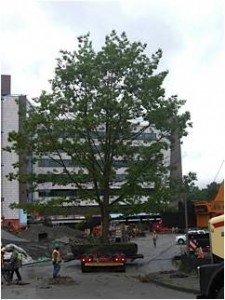
After several years of planning, Seattle Children’s will open its new Building Hope expansion for cancer, critical and emergency care in a mere 10 weeks. Significant attention has gone into creating the most comfortable, safe and practical spaces for our patients and their family.
We’ve also been attentive in making sure sustainable and “green” design elements are being woven into the make-up of the building. It’s part of our effort to maintain our beautiful Pacific Northwest environment, and because we know that green architecture is healthiest for our staff and those we serve.
Saving energy, water and preserving habitat
Children’s goal is to obtain Leadership in Energy and Environmental Design (LEED) Gold certification from the U.S. Green Building Council shortly after Building Hope opens. To do that, we have to meet eco-friendly standards for site development, resource consumption, materials selection and the indoor environment – the building blocks of sustainable design and construction.
In an effort to obtain LEED Gold certification, we’ve taken habitat, energy and water into consideration to reduce demand on local infrastructure. These elements contribute to a sustainable urban campus and, by extension, positively affect the community around us.
With the help of our various partners, including ZGF Architects, Sellen Construction and Seneca Group, Building Hope will include the following sustainable and green features:
Energy
- Energy use is projected to more than 40 percent below that of similarly sized hospitals.
- Construction equipment is being powered by biofuels to maintain indoor and outdoor air quality.
Water
- Plumbing fixtures will reduce water use by nearly 30 percent of what’s traditionally used in hospitals.
- Plants in rain gardens will clean water from paved surfaces and provide additional habitat for birds.
Habitat
- More than 4,000 plants, shrubs and trees were salvaged from the construction site and replanted on the hospital’s campus. This included 393 bulbs, 136 ferns, 316 grasses, 1,132 ground covers, 985 perennials, 1,000 shrubs and 330 trees.
- Over 50 percent of wood content being used in Building Hope is sustainably harvested.
- A green roof will provide habitat for urban species and its permeable pavers will allow water infiltration to reduce storm water runoff.
- Wood and wood-containing products are free of toxic urea-formaldehyde binders and adhesives.
Recycling and transportation improvements
In addition, over 90 percent of Building Hope construction and demolition debris has been diverted from landfills through recycling and material reuse.
“Seattle Children’s has one of the highest hospital recycle rates in the region, if not the whole country,” said Paulo Nunes-Ueno, transportation and sustainability director at Seattle Children’s. “Moving forward, more than 40 percent of all our waste in Building Hope and our existing hospital campus will continue to be recycled.”
Children’s is also investing more than $4 million in transportation improvements around the hospital that include enhancements for safer biking and walking. According to Nunes-Ueno, “We not only want to be good environmental stewards, we want to invest in making our community safer and more livable.”
Additional Resources
- Construction page
- Building Hope, Part 1: Top Ten Features – Cancer Inpatient Unit
- Building Hope, Part 2: Early Look at the New Emergency Department
For Media
If you’re a member of the media and would like to learn more about Building Hope, please contact Children’s PR team at 206-987-4500 or at [email protected].

